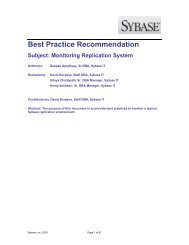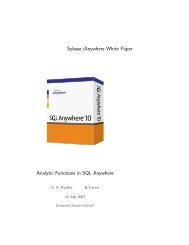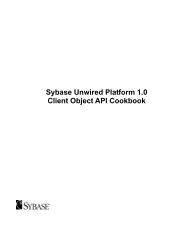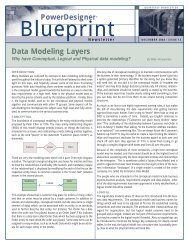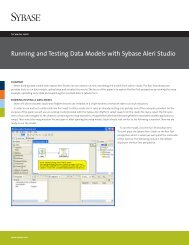Optimizing Transaction Performance in Adaptive Server ... - Sybase
Optimizing Transaction Performance in Adaptive Server ... - Sybase
Optimizing Transaction Performance in Adaptive Server ... - Sybase
Create successful ePaper yourself
Turn your PDF publications into a flip-book with our unique Google optimized e-Paper software.
5.1 Guidel<strong>in</strong>es for Configur<strong>in</strong>g the ULC<br />
To determ<strong>in</strong>e the correct size for the user log cache, identify the maximum number of log records written by<br />
the applications transaction and configure the ‘user log cache size’ to that value. The ULC size should also be<br />
validated, by runn<strong>in</strong>g sp_sysmon dur<strong>in</strong>g the representative workload. If the value for "ULC Flushes to Xact<br />
Log" is high on account of "by Full ULC" then <strong>in</strong>creas<strong>in</strong>g the "user log cache size" would help. In the follow<strong>in</strong>g<br />
snippet, the percentage of ULC flushes on account of the ULC be<strong>in</strong>g full is 70%, so <strong>in</strong>creas<strong>in</strong>g the ULC size <strong>in</strong><br />
this case would help.<br />
ULC Flushes to Xact Log per sec per xact count % of total<br />
------------------------- ------- -------- ------ ---------<br />
by Full ULC 21.0 55.0 5435 70.0 %<br />
If there is a high percentage of "ULC Flushes to Xact Log" on account of "By change of database", it would<br />
help to see if the application can potentially use a s<strong>in</strong>gle database.<br />
ULC Flushes to Xact Log per sec per xact count % of total<br />
------------------------- ------- -------- ----- ----------<br />
by change of database 13.0 30.0 4356 57.0 %<br />
If there is a high percentage of "ULC Flushes to Xact Log" on account of "By Other", one of the potential<br />
causes could be on account of hav<strong>in</strong>g a number of row locked tables. Selectively identify<strong>in</strong>g tables, which<br />
require row level lock<strong>in</strong>g scheme us<strong>in</strong>g sp_object_stats and hav<strong>in</strong>g page level lock<strong>in</strong>g scheme for the rema<strong>in</strong><strong>in</strong>g<br />
tables, could potentially alleviate this problem.<br />
ULC Flushes to Xact Log per sec per xact count % of total<br />
------------------------- --------- ------- ------ ---------<br />
by Other 0.0 0.0 8934 89.0 %<br />
If the "Log Semaphore Requests" waited value is a high percentage, it would help to evaluate some of the<br />
"Advanced ASE logg<strong>in</strong>g features" such as "Async Log Service". More details are provided <strong>in</strong> the "Advanced ASE<br />
logg<strong>in</strong>g features" section.<br />
6. Advanced ASE Logg<strong>in</strong>g Feature<br />
<strong>Sybase</strong> ASE has proven time and aga<strong>in</strong> as the database server of choice for high throughput OLTP applications<br />
hav<strong>in</strong>g very str<strong>in</strong>gent response time requirements. <strong>Server</strong> consolidation and database consolidation are real<br />
trends emerg<strong>in</strong>g <strong>in</strong> the market. Customers are constantly upgrad<strong>in</strong>g their hardware from 4-8 CPU systems to<br />
16-32 and even to 64 CPU mach<strong>in</strong>es capable of execut<strong>in</strong>g millions of transactions for easier management and<br />
lower total cost of ownership. ASE’s architecture keeps pace with the ever-<strong>in</strong>creas<strong>in</strong>g number of CPUs.<br />
Additional CPUs, <strong>in</strong>creases contention on some of the key shared resources such as the log and sp<strong>in</strong>locks<br />
guard<strong>in</strong>g other key resources. To enable ASE to scale on such state of the art hardware, a new service called<br />
"Asynchronous Logg<strong>in</strong>g" is <strong>in</strong>troduced <strong>in</strong> ASE 12.5.0.3. The core idea of this service is to elim<strong>in</strong>ate the burden<br />
of writ<strong>in</strong>g the log data by the user tasks and charter<strong>in</strong>g dedicated threads to write the ULC data to the log<br />
cache and also flush<strong>in</strong>g the log cache to disk. This may improve the performance significantly while<br />
elim<strong>in</strong>at<strong>in</strong>g the log contention almost completely.<br />
To enable the Asynchronous Logg<strong>in</strong>g service on a specific database <strong>in</strong> ASE 12.5.0.3, issue the follow<strong>in</strong>g command.<br />
sp_dboption , "async logg<strong>in</strong>g service", "true"<br />
6



